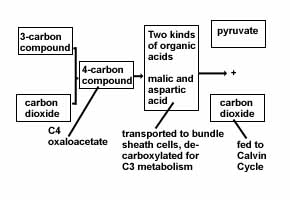PhotosynthesisLife on earth depends utterly on the flow of energy from a nuclear reactor- the sun- to the earth. The amount of energy delivered to the earth each year is quite large: 13 x 1023 calories. A calorie is the amount of energy required to raise the temperature of 1 gm of water 1°C. To put this into a bit of perspective, each day, the earth receives energy from the sun equivalent to 1 million Hiroshima-sized atomic bombs. The earth and the atmosphere immediately reflect about 55% of this energy back into space. The remaining 45% is absorbed and converted largely to heat, which in turn is mostly radiated back out into space. Only about 0.1% of the light energy capable of being converted to chemical energy is in fact converted. If one knows how long the sun shines at a given location for all seasons of the year, one can calculate the energy that a square meter receives as a function of time. That calculated value is the upper limit on the "productivity" of that square meter of the earth's surface. In fact, the actual upper limit is always far less than the theoretical upper limit because of inefficiencies in the collection system. A couple of additional notions: Respiration, which produces carbon dioxide and water, is constantly being balanced against photosynthesis in both nature and in agriculture. The light intensity where the amount of carbon dioxide fixed via photosynthesis is exactly equal to the carbon dioxide produced by respiration in a plant is called the compensation point. A leaf working at just the compensation point is contributing nothing to the buildup of biomass for the plant. Photosynthesis, in fact, must exceed respiration by a considerable amount to accumulate biomass, that is, to say that the plant is being productive. The object of agriculture is to get as much plant productivity (increase in biomass) as possible. Indeed, farmers attempt to achieve a photosynthesis/respiration ratio as high as 40:1. What do they manipulate to do this?
A very nice table of estimates of Net Primary Productivity and Biomass for Various Ecosystems was presented in Northington and Schneider, The Botanical World, 2nd Edition, 1996, Wm. C. Brown, Chicago. This table was derived from data from Whittaker's, Communities and Ecosystems, 1970, Macmillan, London, England. Things which affect biomass production and oxygen evolution:
These places are exceptionally productive places in a biological sense. The 5th Amendment to the Constitution of the United states states, in part:
What does this mean? What do you know about Wetlands Law? On the respiration side of it all, one burns or oxidizes the sugars that are produced by plants. The process is called respiration and occurs partially in the cytoplasm and partially in the mitochondria of all living cells. A lot has just been iterated about productivity, about producing oxygen and fixing carbon dioxide and increasing biomass. Just how is this done? The first step in the conversion of light energy to chemical energy is the absorption of light. A pigment called chlorophyll is the primary absorber in green plants. When pigments absorb light, there are 3 possible consequences:
Some colors of light are more efficiently used by chlorophyll than are others. Light then excites or raises chlorophyll to a higher energy state. As chlorophyll returns to its usual energy state, it passes this energy along a series of carriers. 
In the process, ATP and NADPH are produced. This represents the so called light reactions. The actual fixation of carbon dioxide occurs in the dark reactions. The following is the 3-carbon pathway: 
There is also a 4 carbon sugar photosynthetic pathway that some plants have. See below: 
Why a 4 carbon pathway? Well, this pathway is found in plants well adapted to high temperatures, dry climates and high light levels. Under these conditions, C4 plants are more effective users of carbon dioxide. The enzyme that joins the three carbon compound to carbon dioxide has a high affinity for CO2 even when the CO2 concentration is low. This allows the plants to photosynthesize, even when conditions are adverse. You may take a quiz on the material in this module. No record of the quiz is made. You decide after the quiz if you really know this material. Return to the Syllabus Page. |